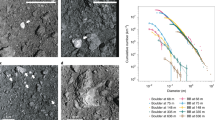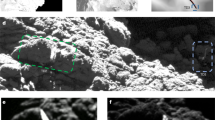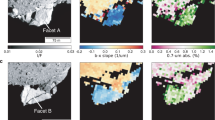Abstract
The Kuiper belt is a disk-like structure consisting of solid bodies orbiting the Sun beyond Neptune1. It is the source of the short-period comets and the likely repository of the Solar System's most primitive materials2. Surface temperatures in the belt are low (∼ 50 K), suggesting that ices trapped at formation should have been preserved over the age of the Solar System. Unfortunately, most Kuiper belt objects are too faint for meaningful compositional study, even with the largest available telescopes. Water ice has been reported in a handful of objects3,4,5, but most appear spectrally featureless5,6. Here we report near-infrared observations of the large Kuiper belt object (50000) Quaoar, which reveal the presence of crystalline water ice and ammonia hydrate. Crystallinity indicates that the ice has been heated to at least 110 K. Both ammonia hydrate and crystalline water ice should be destroyed by energetic particle irradiation on a timescale of about 107 yr. We conclude that Quaoar has been recently resurfaced, either by impact exposure of previously buried (shielded) ices or by cryovolcanic outgassing, or by a combination of these processes.
This is a preview of subscription content, access via your institution
Access options
Subscribe to this journal
Receive 51 print issues and online access
$199.00 per year
only $3.90 per issue
Buy this article
- Purchase on Springer Link
- Instant access to full article PDF
Prices may be subject to local taxes which are calculated during checkout




Similar content being viewed by others
References
Jewitt, D. & Luu, J. Discovery of the candidate Kuiper belt object 1992 QB1. Nature 362, 730–732 (1993)
Davies, J. & Barrera, L. (eds) The First Decadal Review of the Edgeworth-Kuiper Belt (Kluwer Academic, Dordrecht, 2004)
Brown, R. H., Cruikshank, D. P. & Pendleton, Y. Water ice on Kuiper Belt object 1996 TO66. Astrophys. J. Lett. 519, 101–104 (1999)
Fornasier, S., Dotto, E., Barucci, M. A. & Barbieri, C. Water ice on the surface of the large TNO 2004 DW. Astron. Astrophys 422, L43–L46 (2004)
Jewitt, D. C. & Luu, J. X. Colors and spectra of Kuiper Belt Objects. Astron. J. 122, 2099–2114 (2001)
Licandro, J., Ghinassi, F. & Testi, L. Infrared spectroscopy of the largest known trans-Neptunian object 2001 KX76. Astron. Astrophys. 388, L9–L12 (2002)
Brown, M. E. & Trujillo, C. A. Direct measurement of the size of the large Kuiper Belt object (50000) Quaoar. Astron. J. 127, 2413–2417 (2004)
Motohara, K. et al. CISCO: Cooled infrared spectrograph and camera for OHS on the Subaru telescope. Publ. Astron. Soc. Jpn 54, 315–325 (2002)
Marchi, S., Lazzarin, M., Magrin, S. & Barbieri, C. Visible spectroscopy of the two largest known trans-Neptunian objects: Ixion and Quaoar. Astron. Astrophys. 408, L17–L19 (2003)
Cruikshank, D. P. et al. The composition of Centaur 5145 Pholus. Icarus 135, 389–407 (1998)
Grundy, W. M. & Schmitt, B. The temperature-dependent near-infrared absorption spectrum of hexagonal H2O ice. J. Geophys. Res. 103, 25809–25822 (1998)
Schmitt, B., Quirico, E., Trotta, F., Grundy, W. M. in Solar System Ices (eds Schmitt, B., de Bergh, C. & Festou, M.) 199–240 (Vol. 227, Astrophysics and Space-Science Library, Kluwer Academic, Dordrecht, 1998).
Dalton, J. B., Curchin, J. M. & Clark, R. N. Temperature dependence of cryogenic ammonia-water ice mixtures and implications for icy satellite surfaces. Lunar Planet. Inst. Conf. Abstr. 32, 1496 (2001)
Owen, T. C. et al. Surface ices and the atmospheric composition of Pluto. Science 261, 745–748 (1993)
Brown, M. E. & Calvin, W. M. Evidence for crystalline water and ammonia ices on Pluto's satellite Charon. Science 287, 107–109 (2000)
Dumas, C., Terrile, R. J., Brown, R. H., Schneider, G. & Smith, B. A. Hubble Space Telescope NICMOS spectroscopy of Charon's leading and trailing hemispheres. Astron. J. 121, 1163–1170 (2001)
Jenniskens, P., Blake, D. F., Kouchi, A. in Solar System Ices (eds Schmitt, B., de Bergh, C. & Festou, M.) 139–155 (Vol. 227, Astrophysics and Space-Science Library, Kluwer Academic, Dordrecht, 1998)
Choi, Y., Cohen, M., Merk, R. & Prialnik, D. Long-term evolution of objects in the Kuiper Belt zone—Effects of insolation and radiogenic heating. Icarus 160, 300–312 (2002)
Lanzerotti, L. J., Brown, W. L., Marcantonio, K. J. & Johnson, R. E. Production of ammonia-depleted surface layers on the saturnian satellites by ion sputtering. Nature 312, 139–140 (1984)
Hansen, G. B. & McCord, T. B. Amorphous and crystalline ice on the Galilean satellites: A balance between thermal and radiolytic processes. J. Geophys. Res. 109, CiteID E01012 (2004)
Strazzulla, G., Leto, G., Baratta, G. A. & Spinella, F. Ion irradiation experiments relevant to cometary physics. J. Geophys. Res. 96, 17547–17552 (1991)
Cooper, J. F., Christian, E. R., Richardson, J. D. & Wang, C. Proton irradiation of Centaur, Kuiper Belt, and Oort Cloud objects at plasma to cosmic ray energy. Earth Moon Planets 92, 261–277 (2003)
Bauer, J. M. et al. The near infrared spectrum of Miranda: Evidence of crystalline water ice. Icarus 158, 178–190 (2002)
Czechowski, L. & Leliwa-Kopystyński, J. Tidal heating and convection in the medium sized icy satellites. Celest. Mech. Dyn. Astron. 87, 157–169 (2003)
Kawakita, H. & Watanabe, J. Revised fluorescence efficiencies of cometary NH2: Ammonia abundance in comets. Astrophys. J. Lett. 572, 177–180 (2002)
Stevenson, D. J. Volcanism and igneous processes in small icy satellites. Nature 298, 142–144 (1982)
Acknowledgements
This paper is based on observations at the Subaru Telescope, which is operated by the National Astronomical Observatory of Japan. We thank K. Aoki and B. Potter for help with CISCO/Subaru and C. Dumas, Y. Fernandez and T. Owen for helpful comments. This work was supported in part by a grant to D.C.J. from NASA.
Author information
Authors and Affiliations
Corresponding author
Ethics declarations
Competing interests
The authors declare that they have no competing financial interests.
Rights and permissions
About this article
Cite this article
Jewitt, D., Luu, J. Crystalline water ice on the Kuiper belt object (50000) Quaoar. Nature 432, 731–733 (2004). https://doi.org/10.1038/nature03111
Received:
Accepted:
Issue Date:
DOI: https://doi.org/10.1038/nature03111
This article is cited by
-
Relict Ocean Worlds: Ceres
Space Science Reviews (2020)
-
Experimenting with Mixtures of Water Ice and Dust as Analogues for Icy Planetary Material
Space Science Reviews (2019)
-
Dust Phenomena Relating to Airless Bodies
Space Science Reviews (2018)
Comments
By submitting a comment you agree to abide by our Terms and Community Guidelines. If you find something abusive or that does not comply with our terms or guidelines please flag it as inappropriate.



